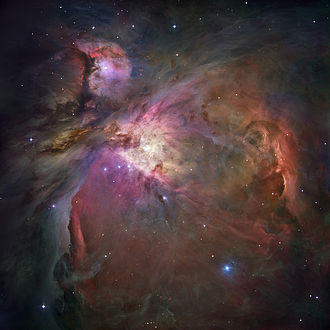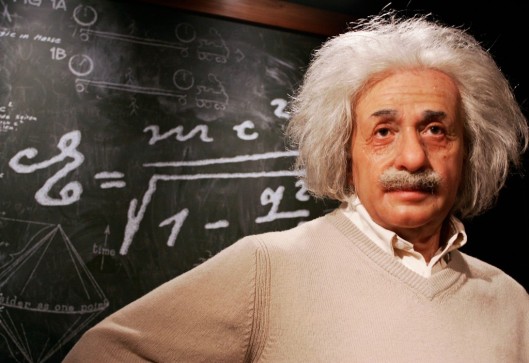This post, which is the latest in my series on cosmology, is about the ultimate fate of the Universe, a subject which has engaged scientists, philosophers and religious leaders for centuries. There are many possible endings to the Universe, but the outline I will present here, which is sometimes called “The Big Freeze”, is the most commonly held view based upon the known laws of science.
4 billion years in the future – Milky Way and Andromeda merge
As readers of my previous posts will recall, the Sun is one of around 400 billion stars in the Milky Way galaxy and the Milky Way is one of over 200 billion galaxies in the observable Universe (ref 1). Our galaxy, together with the large spiral galaxy in the constellation Andromeda and around 50 smaller galaxies form a collection of galaxies called the the Local Group.

The Andromeda galaxy – the nearest large galaxy to the Milky Way. It lies 2.5 million light years, roughly 25 million trillion km, from Earth.
As readers of my previous post The Universe Past, Present and Future will recall, the Universe is expanding and, in general, the further away a galaxy is from us the faster it appears to be moving away from us. This does not apply to the galaxies in the Local Group. In fact, the Andromeda galaxy is moving towards the Milky Way at about 400,000 km/h and the Milky Way and Andromeda are expected to collide in about 4 billion years time. When this happens, a large new single galaxy will be formed. The new galaxy which will be formed by the merger is sometimes called Milkomeda (ref 2) and, over billions of years, it will gradually absorb the other Local Group members.

When this merger occurs it is unlikely than any stars within either galaxy will collide directly because the distances between stars is so great, but the clouds of gas found between stars will collide and merge.
1-10 trillion years in the future – the dark era.
As described in a previous post, stars consume hydrogen to produce helium and later on towards the end of their lives they make heavier elements. New stars are being created all the time from clouds of gas and dust. Many of the beautiful glowing nebulae seen through telescopes consist of glowing gas and dust clouds lit up by newly formed stars.

The Orion Nebula, a region of star formation
However the supply of hydrogen is finite and in about 1 trillion years time there won’t be enough hydrogen left to forms any more new stars (Ref 3). In about 10 trillion years the longest lived stars which are small faint stars called red dwarfs will have come to the end of their lives. All stars which started life with an original mass less than 10 times the mass of the Sun, which is over 97 % of all stars, will have become very dense cold objects called black dwarfs. Very massive stars more than 10 times the mass of the Sun will have become neutron stars or black holes:
- Neutron stars are super dense objects in which the mass of a star is concentrated in a object about 10 km in diameter. A neutron star is so dense that 1 litre of its material would weigh 500 billion tons.
- Black holes are objects in which the gravity is so strong that once an object enters a region around the black hole called the event horizon it cannot escape. Much has been written about black holes by popular science and science fiction writers. For a good overview I would recommended the article by Stephen Hawking article which can be found at http://www.hawking.org.uk/into-a-black-hole.html

Hot swirling gas around a black hole
None of these object emits any light so the observable Universe in 10 trillion years will be very dark and very cold, having a temperature a fraction above the lowest possible temperature which physicists call absolute zero. It will consist of black dwarfs, neutron stars and black holes, planets and other smaller bodies associated with them. At the centre of Milkomeda will be a large black hole many millions times the mass of the Sun.
10-100 quintillion years in the future – Milkomeda shrinks
After a number of such collisions an object may get enough energy to escape from Milkomeda. Over a vast period of time, around 100 quintillion years, this will cause the galaxy to gradually shrink as dead stars and possibly their attached planets escape, and the remaining objects would be more tightly bound.
100,000-1,000,000 quintillion years in the future -Gravitational radiation causes objects to fall into a massive black hole
In 1916 Albert Einstein predicted the existence of gravitational waves. One object orbiting another will emit something called “gravitational radiation” causing it to lose energy and spiral slowly inwards towards the more massive object.

Assuming Einstein’s theory is correct, then also assuming that
- the Earth has survived the Sun’s red giant phase (which is unlikely) and
- that it not been detached from the Solar System by a near collision with a passing star (which almost certainly will happen if we wait long enough)
in 100,000 quintillion years time it will spiral down to the surface of the Sun (see note 2). It also means that, over an even longer timescale of about 1,000,000 quintillion years, the eventual fate of all the massive objects which have not escaped from the galaxy is to fall into the super massive black hole which lies at its centre!
Related Posts
This post is the sixth in my series about cosmology. The others can be viewed at
https://explainingscience.org/tag/cosmology/
Notes
1 The distances in this table should be considered as very approximate. It assumes for simplicity that the Hubble parameter does not change over time (which is not the case)
2 In reality the Earth would be broken apart by tidal forces due to the remnant Sun’s gravity before it hit the remnant Sun’s surface.
Updated 28 April 2021
References
1 Cain, F (2013) How Many Stars are There in the Universe?, Available at:http://www.universetoday.com/102630/how-many-stars-are-there-in-the-universe/(Accessed: 19 February 2015).
2 http://phenomena.nationalgeographic.com/2014/03/24/scientists-predict-our-galaxys-death/
3 Barrow, J D and Tipler F J. The Anthropic Cosmological Principle 1996 pp641. ISBN 0-19-282147-4.

So interesting! So, eventually, we either escape or be destroyed.
LikeLike
Yes it is fascinating !!
LikeLiked by 1 person
[…] In fact our the Milky Way and Andromeda are on a collision course and will collide in about 4 billion years’ time. The is described in more detail in my previous post: The Ultimate Fate of the Universe. […]
LikeLike
[…] (6) The ultimate fate of the Universe. To view this post click here. […]
LikeLike
Really Like your post, It’s awwwsome….
LikeLike
Reblogged this on Neuroscience Is The New Black and commented:
But what will happen too the neutrinos?
LikeLike
I wondered why on a recent astronomy programme on tv about black holes why dark matter was never mentioned? Are the two related?
LikeLike
Hi Erikleo and thanks for your comment.
The two aren’t really related.
Black holes are objects where the gravitational field is so strong that nothing- not even light can escape.
Dark matter is an, as yet undetected, form of matter which is believed to constitute most of the matter in the Universe. My recent post http://thesciencegeek.org/2015/02/18/dark-matter/ describes dark matter in more detail.
The Science Geek
LikeLike
Very interesting post, as are all of yours.
Perhaps at some point you might consider posts on time travel and if it is possible for the laws of physics to change or be broken.
LikeLike
Reblogged this on Carlos Arias Delgado.
LikeLike
Of course, dark energy and dark matter are still very mysterious, so they may turn up some surprising new behaviour on such long timescales.
LikeLike
Yes, I have followed that argument, but the obvious question to ask is, can it speed up indefinitely? What really happens to mass and energy (not the dark stuff) when the speed of light is reached and exceeded? It seems to me the mathematics that has evolved to described the cosmology will break down. Not that the reality or otherwise of the situation is likely to engage any of us!!
LikeLike
Hi Bookheathen,
An interesting comment. What happens is that, as galaxy get further away from us, the faster it moves away. When it reaches a certain distance which is roughly 15 billion light years away from us, a galaxy would be moving faster away from us than the speed of light and we can no longer see it.
This does not give any conflict with relativity which states only that no material effect can travel faster than the speed of light
Simply speaking this distance of 15 billion light years which is sometimes called the Hubble Sphere forms a kind of boundary to the observable Universe, beyond this distance there are (possibly an infinite number of) galaxies which are moving away from so fast we can’t see them.
The Science Geek
LikeLike
Fascinating theory -but I wonder if the concept of 110 billion years stretches suspension of disbelief too far. Have we gone off completely the idea of a ‘big crunch’? I enjoy reading your posts.
LikeLike
Hi Bookheathen,
Gad you’re enjoying reading my posts.
I agree that 110 billion years is an incredibly long period of time compared to normal timescales, given that the Universe is believed to be “only” 13.7 billion years old.
It is generally accepted that the big crunch wn’t happen. Recent observations have shown that the expansion of the Universe is speeding up. My previous post on dark energy discusses this in more detail.
The Science Geek
LikeLike
Reblogged this on Notes from the Overground .
LikeLike